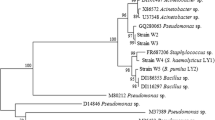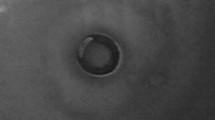Abstract
Tributyl phosphate (TBP) is an organophosphorous compound, used extensively (3000–5000 tonnes/annum) as a solvent for nuclear fuel processing and as a base stock in the formulation of fire-resistant aircraft hydraulic fluids and other applications. Because of its wide applications and relative stability in the natural environment TBP poses the problem of pollution and health hazards. In the present study, fifteen potent bacterial strains capable of using tributyl phosphate (TBP) as sole carbon and phosphorus source were isolated from enrichment cultures. These isolates were identified on the basis of biochemical and morphological characteristics and 16S rRNA gene sequence analysis. Phylogenetic analysis of 16S rRNA gene sequences revealed that two isolates belonged to class Bacilli and thirteen to β and γ-Proteobacteria. All these isolates were found to be members of genera Alcaligenes, Providencia, Delftia, Ralstonia, and Bacillus. These isolates were able to tolerate and degrade up to 5 mM TBP, the highest concentration reported to date. The GC–MS method was developed to monitor TBP degradation. Two strains, Providencia sp. BGW4 and Delftia sp. BGW1 showed respectively, 61.0 ± 2.8% and 57.0 ± 2.0% TBP degradation within 4 days. The degradation rate constants, calculated by first order kinetic model were between 0.0024 and 0.0099 h−1. These bacterial strains are novel for TBP degradation and could be used as an important bioresource for efficient decontamination of TBP polluted waste streams.






Similar content being viewed by others
References
Ahire KC, Arora MS, Mukherjee SN (2008) Residue analysis of Lufenuron in milled wheat by gas chromatography–mass spectrometry (GC–MS) and monitoring its bio-efficacy against Tribolium castaneum (Herbst) (Coleoptera: Tenebrionidae). J Chromatogr B 861:16–21
Arnold LL, Christenson MC, John MK, Wahale BS, Cohen SM (1997) Tributyl phosphate effects on urine and bladder epithelium in male Sprague-Dawley rats. Fundam Appl Toxicol 40:247–255
Auletta CS, Weiner ML, Richter WR (1998) A dietary toxicity/oncogenicity study of tributyl phosphate in the rat. Toxicology 128:125–134
Berne C, Montjarret B, Guountti Y, Garcia D (2004) Tributyl phosphate degradation by Serratia odorifera. Biotechnol Lett 26:681–686
Berne C, Allainmat B, Garcia D (2005) Tributyl phosphate degradation by Rhodopseudomonas palustris and other photosynthetic bacteria. Biotechnol Lett 27:561–566
Berne C, Pignol D, Lavergne J, Garcia D (2007) CYP201A2, a cytochrome P450 from Rhodopseudomonas palustris, plays a key role in the biodegradation of tributyl phosphate. Appl Microbiol Biotechnol 77:135–144
Brosius J, Palmer ML, Kennedy PJ, Noller HF (1978) Complete nucleotide sequence of a 16S ribosomal RNA gene from Escherichia coli. Proc Natl Acad Sci USA 75:4801–4805
Collins CH, Lyne PM, Grange JM (1995) Collins and Lyne’s microbiological methods, 7th edn. Butterworth-Heinemann, London, U.K
Dodi A, Verda G (2001) Improved determination of tributyl phosphate degradation products (mono- and dibutyl phosphates) by ion chromatography. J Chromatogr A 920:275–281
Fries E, Puttmann W (2003) Monitoring of the three organophosphate esters TBP, TCEP and TBEP in river water and ground water (Oder, Germany). J Environ Monit 5:346–352
Hernandez O (2002) Tributyl phosphate—SIDS initial assessment report for 12th SIAM. UNEP Publications. http://www.chem.unep.ch/irptc/sids/OECDSIDS/126-73-8.pdf. Accessed 13 March 2008
Katewa SD, Katyare SS (2003) A simplified method for inorganic phosphate determination and its application for phosphate analysis in enzyme assays. Anal Biochem 323:180–187
Kitts CL, Cunningham DP, Unkefer PJ (1994) Isolation of three hexahydro-1,3,5-trinitro-1,3,5-triazine-degrading species of the family Enterobacteriaceae from nitramine explosive-contaminated soil. Appl Environ Microbiol 60:4608–4611
Lamouroux C, Virelizier H, Moulin C, Tabet JC, Jankowski CK (2000) Direct determination of dibutyl and monobutyl phosphate in a tributyl phosphate/nitric aqueous-phase system by electrospray mass spectroscopy. Anal Chem 72:1186–1191
Lane DJ (1991) 16S/23S rRNA sequencing. In: Stackebrandt E, Goodfellow M (eds) Nucleic acid techniques in bacterial systematics. John Wiley & Sons Inc., Chichester, pp 115–175
Li J, Liu J, Shen W, Zhao X, Hou Y, Cao H, Cui Z (2010) Isolation and characterization of 3,5,6-trichloro-2-pyridinol-degrading Ralstonia sp. strain T6. Bioresour Technol 101:7479–7483
Macrina FL, Kopecko DJ, Jones KR, Ayers DJ, McCowen SM (1978) A multiple plasmid-containing Escherichia coli strain: convenient source of size reference plasmid molecules. Plasmid 1:417–420
Makas AL, Troshkov ML (2004) Field gas chromatography–mass spectrometry for fast analysis. J Chromatogr B 800:55–61
Marklund A, Andersson B, Haglund P (2005a) Organophosphorus flame retardants and plasticizers in air from various indoor environments. J Environ Monit 7:814–819
Marklund A, Andersson B, Haglund P (2005b) Organophosphorus flame retardants and plasticizers in Swedish sewage treatment plants. Environ Sci Technol 39:7423–7429
Meyer J, Beser K (2004) Organophosphate flame retardants and plasticizers in wastewater treatment plants. J Environ Monit 6:599–605
Michel K, Brinkmann C, Hahn S, Dott W, Eisentraeger A (2004) Acute toxicity investigations of ester based lubricants by using biotests with algae and bacteria. Environ Toxicol 19:445–448
Nakamura A (1991) International programme on chemical safety—environmental health criteria 112-tri-n-butyl phosphate. World Health Organisation Publication, Geneva. http://whqlibdoc.who.int/ehc/WHO_EHC_112_eng.pdf
Owen S, Jeong BC, Poole PS, Macaskie LE (1992) Tributyl phosphate degradation by immobilized cells of Citrobacter sp. Appl Biochem Biotechnol 34:693–707
Raushel FM (2002) Bacterial detoxification of organophosphate nerve agents. Curr Opin Microbiol 5:288–295
Saitou N, Nei M (1987) The neighbor-joining method: a new method for reconstructing phylogenetic trees. Mol Biol Evol 4:406–425
Schulz WW, Navratil JD (eds) (1987) Science and technology of tributyl phosphate, vol 2, part B. CRC Press Inc., Boca Raton, FL
Singh BK, Walker A (2006) Microbial degradation of organophosphorus compounds. FEMS Microbiol Rev 30:428–471
Stoner D, Tien A (1995) Method and compositions for the degradation of tributyl phosphate in chemical waste mixtures. US Patent 5,453,375
Tamura K, Dudley J, Nei M, Kumar S (2007) MEGA4: Molecular Evolutionary Genetics Analysis (MEGA) software version 4.0. Mol Biol Evol 24:1596–1599
Thomas RA, Macaskie LE (1996) Biodegradation of tributyl phosphate by naturally occurring microbial isolates and coupling to the removal of uranium from aqueous solution. Environ Sci Technol 30:2371–2375
Thomas RA, Macaskie LE (1998) The effect of growth conditions on the biodegradation of tributyl phosphate and potential for the remediation of acid mine drainage waters by a naturally-occurring mixed microbial culture. Appl Microbiol Biotechnol 49:202–209
Thomas RAP, Greated A, Lawlor K, Bailey M, Macaskie LE (1997a) Stabilisation of tributyl phosphate-biodegradative ability of naturally-occurring pseudomonads using ampicillin. Biotechnol Tech 11:781–785
Thomas RAP, Morby AP, Macaskie LE (1997b) The biodegradation of tributyl phosphate by naturally occurring microbial isolates. FEMS Microbiol Lett 155:155–159
Tolbot HW, Johnson LM, Munneck DM (1984) Glyphosate utilization by Pseudomonas sp. and Alcaligenes sp. isolated from environmental sources. Curr Microbiol 10:255–260
US EPA (1992) Chemical testing & data collection—tributyl phosphate test results. US Environmental Protection Agency Publication, Washington. http://www.epa.gov/opptintr/chemtest/pubs/tributph.html. Accessed 16 February 2009
Xu XR, Li HB, Gu JD (2005) Biodegradation of an endocrine-disrupting chemical di-n-butyl phthalate ester by Pseudomonas fluorescens B-1. Int Biodeter Biodegrad 55:9–15
Zhang GS, Jia XM, Cheng TF, Ma XH, Zhao YH (2005) Isolation and characterization of a new carbendazim-degrading Ralstonia sp. strain. World J Microbiol Biotechnol 21:265–269
Acknowledgments
Kedar Ahire acknowledges the Council of Scientific and Industrial Research (CSIR), Government of India and Board of College and University Development (BCUD), University of Pune for the financial assistance. Authors thank Dr. Vijay Kolekar, In-charge, Insecticide Residue Testing Laboratory, Pune (Govt. of India) for GC–MS facility.
Author information
Authors and Affiliations
Corresponding author
Rights and permissions
About this article
Cite this article
Ahire, K.C., Kapadnis, B.P., Kulkarni, G.J. et al. Biodegradation of tributyl phosphate by novel bacteria isolated from enrichment cultures. Biodegradation 23, 165–176 (2012). https://doi.org/10.1007/s10532-011-9496-7
Received:
Accepted:
Published:
Issue Date:
DOI: https://doi.org/10.1007/s10532-011-9496-7




